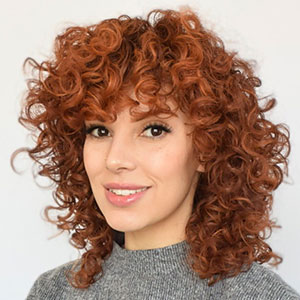
Get the latest Academy content and special deals direct to your inbox
When learning different razor cutting hair techniques, it’s fundamental to understand razor stroke, razor angle and hair tension. Razor cutting hair techniques for beginners include understanding the difference between a short and long razor stroke. In this video you will learn how to cut hair with a razor and how a short and long razor stroke give different results.
In the salon, these razor cutting techniques will help you create the desired look and styling effects you’re going for so take these cutting tips and precision hair cutting techniques and incorporate your learnings into your haircuts.
Watch this tutorial video and follow along with the transcript in this article on how to razor hair.
Welcome back to the Jatai Academy. Today we’re going to be doing a razor cut where we compare the differences between how to razor cut hair using a long broad razor stroke versus a very tight short razor stroke.
So we’re going to start here on one side of the head. The razor used in this tutorial is our Feather Plier Razor which is a professional razor for hair cutting. And I’m going to show you how to hold it. We’re going to put it deep between my forefinger and middle finger push the blade out towards my fingertip and use just my fingertip to give it some movement.
I’m going to take my first section, determine my length overall and then start cutting from the center of the hairline all the way down towards the perimeter. And I’m going to take a very very tight razor stroke here.
I’m pulling everything forward and cutting straight up and down perpendicular so this is going to give me kind of a feathered look and that’s what we’re going to go for. And you’ll be able to see the differences between a long stroke and a short stroke.
So I’m pulling everything forward using my center guide that I chose where it would fall on the face, pulling everything forward and just follow through with the cutting razor. Now the thing is when you’re using a short stroke like this I want to maintain some consistency with my stroke.

So this is the elevation that I’m holding out for each section that I take. I’m going to pull it forward, get the right elevation, find my guide underneath, open up my blade. There’s my guide and I’m just going to follow cutting directly on top of the guide.
Now here you’ll be able to see as I start at the base of the blade cutting with razor and then move towards the tip of the blade so that it evenly wears out the blade. Because if I only use the tip it’s going to dull the tip pretty quick and then I have the rest of the blade that’s sharp and then I end up throwing it away. I’m going to check the result and make sure that we’re looking good.
Now I’m going to continue to work back towards the head and I take a flat section of head that’s going to determine my size of the section and you also see the elevation. So as I work back my elevation gets higher and higher and I’m pulling everything thing forward even right on top of the previously cut guide.
The only thing that changes is the elevation and the head shape is going to show me the elevation, combing everything clean from the root all the way out continuing a nice short stroke all the way through.
Continuing to pivot around the ear taking little flat sections to determine the size of my section and then I’m showing you the elevation. Now as I start to work towards the back you’ll notice I tilt the model’s head down so it makes it easier for me to get into that correct elevation.
There’s my guide underneath. Start at the base of the blade then work out towards the tip as I work through my sections. A tight razor stroke is going to give me a much more solid shape.
So if someone has finer hair I may want to use a really tight stroke versus a really broad stroke and this type of method of me elevating as I work towards the back is actually going to cut a curved line shorter in the front gradually curving to longer length in the back. And just continuing to work all the way through.
Continuing all the way back, just following the same methodology working my guides back, I’m going to pin some of this hair underneath out of the way so it doesn’t get in the way, gives me less hair to work with and it makes it easier to control.
There’s my elevation. Hold that up, take my razor, go through and cut that as smoothly and as consistently as I could all the way from the beginning to the end. That’s not the smoothest razor action that I’ve ever seen myself do but you know we try to keep it as consistent as possible.
One thing as I’m watching this that would help is if I kept a consistent tension on it. Sometimes I notice I was allowing the tension to sag and that will make it a little bit harder to cut.
Continuing to pull everything up at elevation to continue this curved layering line from the front all the way to the back. Now this next section I don’t think I’m going to have a whole lot of hair and I didn’t. So here’s our end result on the left side which is the short razor stroke.
And now we’re going to take a little piece right in the middle as our guide and I’m going to go through and follow the same sectioning patterns that I had on the left side on the right side. The only thing that’s going to change is the broadness of my razor stroke.
So you can certainly see here how much broader that razor stroke is and how much softer of a line that I’m going to get. Now one thing that I have to really pay attention to when cutting hair with razor is that this side is going to have a lot more texture to it. It’s going to feel shorter.

And also another thing is when I’m working through a broad razor stroke like this, the guide is a little harder to see. So I need to be particularly mindful to pay attention to where my guide is so I can stay on top of my guide.
Keep a broad razor stroke as consistent as possible. I don’t want to have one part a little tighter stroke and the other part a little looser. I want to keep it as even as possible.
And now you’ll see that I start to elevate the same as I did on the other side, just following whatever the head shape is. Broad razor stroke all the way through. Consistency is key.
Follow us on your favorite social media platform @jataifeather
We got Facebook, Instagram, Twitter, Pinterest, TikTok. We’ve got it all.
Continuing to pivot my partings as I go back using the flat parts of the head to determine the section width and then using the head shape to determine my elevation. Continuing to pull everything forward and up parallel to my parting and then following my guide from underneath.
And I’ll keep going until I run out of hair. Checking my guide here, checking the side lengths to make sure that they’re even. So that’s how I would determine if both sides are the same.
As I cut one section, I can compare it to the exact same section on the opposite side of the head. And if it’s the same, then I just keep moving on, keep working towards the back until I run out of hair.
Now since I’m using the Plier it doesn’t have a guard so I have to be a little respectful of the blade and exercise care as I’m taking these real broad razor strokes. On the tight razor stroke, I think it’s easier to control but a broad razor stroke sometimes I get a little too excited. So I have to be really mindful so I don’t cut myself.
And here we’ve run out of hair and nothing’s uh reaching up to my guide so now we’ve got our end result. I’m going to check both sides to make sure it’s even and I got a little whisper there on the right right side but not looking too bad.

The broad side is going to be much more airy and flicky and you can really see the difference. Both look good but really quite a difference between the two even though it’s the same haircut.
Check out the Jatai Academy for all kinds of fantastic information including how to cut hair using a razor that’ll make you a better hair stylist and barber. You can learn how to do different types of razor hair cuts as well as scissor cuts. We hope you enjoyed this class and that we can contine to be your source for haircutting education. Let us know what you’d like to see in the future thanks so much we’ll see you next time!
A short stroke vs. long stroke when cutting hair with a razor can make a difference in your haircutting results. And using a razor to cut hair vs. scissors also makes a huge difference. This means there are many ways to cut hair just based on the tool used and the technique used. Learning how to cut with a razor is a useful skill that every hairstylist should know. Learning different cutting techniques for hair such as how to remove bulk from hair, how to texturize and create volume using a razor for cutting hair will give you the confidence you need to take your razor cutting to the next level.

JATAI provides innovative and professional quality beauty implements with world-class customer service and educational support. To offer great products as a master distributor, we seek out and select only manufacturers who demonstrate superior workmanship, the most advanced technology, and respected business core values of reliability, honesty and integrity. Accordingly, JATAI represents three major ‘workhorse’ brands that dominate within their categories. Feather, Seki Edge and Fuji Paper. JATAI Academy brings beauty tools to creative life. It’s the ultimate professional information resource where Education, Artistry and Trends CONNECT for Stylists and Barbers.
















